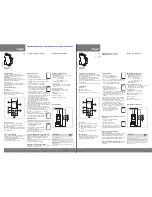
10
RaceAmerica Model 3210 Timer MB
The RS232 Serial Port can be configured for
T-Link Wireless Track Sensors or to interface to a
PC running race management software.
The Serial Port is enabled for two way
communications (in for T-Link data, out for PCs
and displays. The Display port is also a serial port
and transmits data in Chronomix format.
NOTE: When connecting to the Serial Port,
the PC or display must be configured at 9600 baud,
8 data bits, no parity, 1 stop bit, no handshake
(9600/8/N/1).
RF INTEGRITY
When operating the Timer MB with T-Link
wireless sensors, the Radio Frequency Signal
integrity can be monitored. Pressing
[3] RF
on
the keypad will cause connected T-Link units to
monitor the RF signal integrity. The display will
show
[--rF--] [S----F]
. The left dash is the ‘A’
(start line) unit and the right dash is the ‘B’ (finish
line) unit. The dashes on the display will begin to
count up as signals are received from the T-Link
units on the track
[--rF--] [S0--0F]
. 0 displayed
represents 0%, 1 represents 10%, 2 represents
20% etc. until a dash appears representing 100%.
This is an indication of the consistency of the
RF integrity. If this number jumps around, there
is a high level of interference in the area. If the
number remains high, the RF signal strength is
very good. If the number remains low, the RF
integrity is somewhat weak due to the distance
from the ’Z’ unit or a there is a continuous level
of RF interference. The position of the T-Links
and their antennas should be moved to optimize
the RF Integrity level. High gain antennas can be
used to increase RF Integrity.
WIRELESS BATTERY LEVEL
When operating the Timer MB with T-Link
Wireless sensors, The battery level of each
wireless link unit can be monitored from the
console. Press and release the
[6] BATT
key to
monitor the Battery Level of the T-Links on the
track indicated by
[tbAtt-] [S0--0F]
. The dashes
represent ‘A’ sensor (Start) and ‘B’ sensor (Finish).
The dashes will be replaced by the percentage of
battery power remaining. 0 for 0%, 1 for 10%, 2
for 20%, etc and a dash for 100%. Any reading
above 40% should be adequate for hours of
operation.
ALIGNMENT MODE
Hard Wired Sensor Alignment -
To verify hard wired Track Sensors are
properly aligned with their Beam Emitters, select
the hard wired Alignment Mode by pressing the
[5]
ALIGN
key on the Keypad. The Status Display
momentarily indicates the position on each sensor
on the display with letters represent each emitter/
sensor pair
[S----F]
with the SF blinking.
The
[S]
indicates the START emitter/sensor pair, the
[F]
indicates the FINISH line emitter/sensor pair.
The Status Display then changes each digit to a
zero for each sensor being monitored
[S0--0F]
. If
the Beam Emitter and Track Sensor are operating
properly and aligned, the 0 digit will not change.
If the Beam Emitter and Track Sensor are not
properly aligned, the 0 digit for each emitter/sensor
pair will count slowly if slightly out of alignment
or continuously if they are not functioning
properly or way out of alignment. Once the
emitter/sensor pair are aligned properly, the digit
will stop counting. If the alignment is off a little
or intermittent, the digit for that emitter/sensor
pair will count when they float out of alignment.
Remember, the Beam Emitters and Track Sensors
operate on a ‘Line-of-Sight’ concept and may
require shims if they are installed on a street with
a crown. Leaves, people, and other debris will also
break the beams and could give false signals, so
keep everyone and everything clear of the Beam
Emitters and Track Sensor during racing activity.
To maximize the alignment of the emitter/
sensor pairs, it is suggested to rotate the Beam
Emitter slowly left and right until the alignment
for that pair begins to count. This technique will
determine the maximum lateral detection angle.
Rotating the Beam Emitter up and down until the
alignment starts counting determines the maximum




































